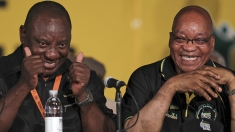New ANC Leadership Provides an Opportunity to Revisit Plans for the Troubled Inga 3 Dam
During its National Elective Conference in December 2017, the African National Congress (ANC) promised to take clean energy from imagination to reality. Launching its Economic Transformation Policy document, which called for “rapidly transforming [the] energy sector” through the use of cleaner energy technologies and a more efficient and reliable power system, committee chair Enoch Godongwana said “renewable energy is here to stay and to grow. It's becoming mainstream.” Meanwhile, ANC's newly elected president, Cyril Ramaphosa, recently called for "significantly expand[ing] our renewable energy programme to fully take advantage of its potential to stimulate growth and jobs."
This would be a welcome move, given the country’s abundant wind and solar potential at some of the world’s most competitive prices.
But the ANC is signaling that the forthcoming Integrated Resource Plan (IRP), which will determine how South Africa will meet long-term electricity demand, will continue to rely on importing new hydropower, such as from the controversial Inga 3 Dam in the Democratic Republic of Congo.
In October 2013, DRC President Joseph Kabila and President Jacob Zuma signed an agreement that South Africa would purchase 2500 MW of power from the proposed Inga 3 Dam. Since then, little progress has been made in developing the project, and the treaty will expire in 2021 unless renewed.
Inga 3 has long been controversial. A previous iteration of the project was intended to sell power to the Southern African Power Pool - South Africa among its recipients - before President Kabila pulled the plug on the deal. Since the project was revived in 2013, it has been hounded by persistent concerns over its enormous price tag, vulnerability to corruption, and impacts on communities and the environment. It has also been criticized for the fact that the bulk of the power would be exported or sold to mining companies and little, if any, power would be left to address stubbornly low access rates in the DRC.
Inga 3 has struggled to attract financing because prospective financiers are skittish about the financial risks of what would be, conservatively, a $14 billion investment: International Rivers produced an economic analysis of the project last year, entitled “In Debt and In The Dark,” that showed a high likelihood that the project would lose millions of dollars every year. The project’s political risks are extremely high as well, with uncertainty over the the duration of Kabila’s reign, and regular political interference: In 2016, the World Bank cancelled its involvement after control of the project was wrested by President Kabila.
Meanwhile, plummeting costs of wind and solar power have changed the assumptions about what is possible. According to a study we commissioned last year, South Africa could meet its electricity needs more cheaply by harnessing its own solar and wind potential. In the most likely scenarios, importing power from Inga 3 would be considerably more expensive; in the worst case, additional expense could rise as high as 4 trillion rand.
South Africa is currently in midst of preparing a new IRP, though it is not being released, which will chart the country’s energy pathway for years and decades to come. With new leadership at the ANC, this is an important moment to take stock of those initiatives and deals from the Zuma era that are worth honoring, and those that should be discarded. As the country moves into the post-Zuma era, dodgy deals like the agreement to buy power from Inga 3 should be left in the past.



